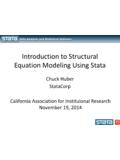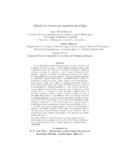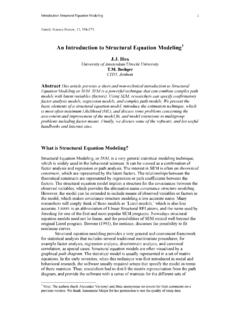Transcription of Laminated Shaly Sand Reservoirs - An Interpretation Model ...
1 SPWLA 43 rd Annual Logging Symposium, June 2-5, 2002 Laminated Shaly Sand Reservoirs - An Interpretation Model incorporating New Measurements Mezzatesta, , Rodriguez, , Mollison, , and Frost, E. ABSTRACT The measurement of anisotropic properties provides valuable information to accurately characterize Shaly - sand Laminated Reservoirs . A petrophysical Model , capable of combining both isotropic and anisotropic formation properties is required for true reservoir characterization. We propose an Interpretation Model that allows for a joint Interpretation of logging data, including NMR, the newly available multi-component resistivity measurements, conventional logs such as gamma ray and density, as well as permeability data from wireline and/or drill-stem formation testing. The proposed petrophysical Model relates the isotropic and anisotropic formation properties with those describing the properties of the sand fraction. The measurements handled by the Model consist of total porosity, total shale volume, lithology indicator(s), NMR derived fluid distribution, and formation permeability.
2 The mathematical equations describing the petrophysical Model are coupled through a set of carefully selected formation parameters reflecting both the bulk formation properties and the properties of the sand fraction itself. The combined Interpretation of the measurements yields, at each depth level, the relative abundance of shale and sand, the shale distribution: laminar, dispersed, structural and, more importantly, a set of improved reservoir property estimates, including sand effective porosity, sand fluid saturations; both irreducible and movable, and sand permeability. Results from the proposed Model reduce reservoir uncertainty and minimize the possibility of missing Reservoirs not easily detected using conventional techniques. The paper describes the mathematical formulation of the petrophysical Model as well as the applied numerical techniques. Optimal Interpretation results are achieved utilizing forward modeling and a constrained, quality- weighted error minimization technique, which also generates parameter confidence intervals based on a sensitivity analysis.
3 Synthetic and real field data examples are presented showing the ability of the Interpretation Model to derive the true reservoir character in Laminated sand-shale environments. INTRODUCTION Numerous authors have described the challenges associated with the evaluation of low resistivity, low contrast Laminated sand-shale reservoir . When the thickness of the laminations is significantly less than the vertical resolution of conventional logging instruments, the formation displays a macroscopic anisotropy with respect to properties such as conductivity and permeability. These properties will have different values dependent on the directionality of the measurements with maximum anisotropy occurring when measured parallel and perpendicular to the bedding planes, transverse anisotropy. In this paper, we build upon the petrophysical models presented by Mollison, et al., 2000 and Mollison and Ragland, 2001. Their petrophysical Model for interpreting sand-shale Reservoirs is based on the concepts of the volumetric shale distribution Model of Thomas and Stieber, 1975, and a tensor resistivity Model to determine laminar shale volume and laminar sand resistivity.
4 The resistivity tensor utilizes macroscopic electrical anisotropy defined by the combination of the horizontal parallel and vertical series resistivity equations, as discussed by Hagiwara, 1994, 1997, 1998, Klein, et al., 1997, Klein, 1996, and Herrick and Kennedy, 1996, among others. In prior work, the Thomas-Stieber volumetric Model utilizes total porosity and shale volume and thus only allows for calculating shale distributions ~r~ terms of either a laminar-structural or laminar-dispersed system. We propose a petrophysical Model that simultaneously incorporates all volumes of distributed shale, laminar, structural, and dispersed, in the corresponding instrument response equations (total porosity, total volume of shale, density, neutron, etc.). A simultaneous solution of these equations allows us to account for the different combinations of shale distribution defined by the volumetric and tensor models to derive the laminar sand reservoir properties.
5 The combined Model and simultaneous solution also allow the estimation of errors in the results originated by either inadequacy in the Model or errors in the parameter selection. The proposed Model also allows for incorporating other measurements such us those derived from NMR (BVI, BVM, CBW). The incorporation of NMR further results in the separation of estimated sand water saturation into its "IT SPWLA 43 rd Annual Logging Symposium, June 2-5, 2002 irreducible and moveable components and deriving a more accurate estimate of sand permeability using the Coates-Timur (Coates et al., 1991) permeability equation. If available, permeabillities from Well Formation Test analysis are also integrated, resulting in a self-consistent Interpretation of all available data. PETROPHYSICAL Model What follows describes in more detail the proposed petrophysical Model . Volumetric Model The volumetric petrophysical Model used in this work for a Laminated Shaly -sand formation is depicted in Figure 1, with the main rock components being laminar shale and sandstone.
6 The laminar shale portion of the rock shows the volumes of dry laminar shale and its associated bound water. The laminar sandstone portion of the rock shows the volumes corresponding to sand matrix, consisting of sand grains; structural shale consisting of dry structural shale and associated bound water; dispersed shale consisting of dry dispersed shale and associated bound water; and effective porosity containing irreducible water and movable fluids consisting of either or both water and hydrocarbon. Assuming a unit volume of rock, the volumes of each of the components described above must add to one. We can write the equation for the bulk volume components as, Vma + Vsh I + Vsh s + Vsh d + V w + Vhc = 1. (1) To avoid Interpretation errors, it is important to clearly differentiate between bulk volumes, referred to as a fraction of the total rock, and the 'laminar sand referenced' volumes, referred to as the laminar sand fraction of the binary rock normalized to 100% sand volume.
7 Throughout the text, we will use the subscript 'sd' to refer to the sand referenced volumes. Using this convention, we can write the equation for the laminar sand fraction components using the sand referenced volumetrics as, V,,,,,~ +Vshs~ ' +Vsnd, ~ +V.,~ +Vhc~, =1. (2) As an example, the volumetric relationship of sand reference~ and bulk dispersed shale volume is given by, V~hd = V~hd ,d (I - Vsh I ). (3) As in the Thomas-Stieber volumetric shale distribution, the Model assumes a constant maximum porosity associated with the sandstone portion of the rock, which can be only filled with dispersed shale and fluids, , water and hydrocarbon. Structural shale can only be present as a replacement of the sand grains, laminar shale replaces the sandstone portion of the rock, including all its components, quartz, dispersed shale, structural shale, and fluids. To honor the shale-sand replacement laws in the Model , we need to introduce two additional equations: the first one considering the replacement of sandstone porosity with dispersed shale, the second one considering the replacement of sandstone grains with structural shale.
8 Both laws take into account the volume of sandstone replacement with laminar shale and can be written as, Cmax (1- Vsh I ) -" Vsh d + V w + Vhc , (4) which establishes that the available rock pore volume can only be occupied with dispersed shale and fluids, and (1. )(1. v, ht ) = v,h, + v,, , (5) which establishes that the available matrix volume can only be occupied with quartz grains and structural shale. The replacement laws introduce range constraints on dispersed and structural shale volumes given by, o <_ V hd < (1" ), (6) and 0 <-- Vsh s <-- (1" ~max )(1" Vsh I ), (7) respectively. In order to define the rock total porosity, it is necessary to consider the volumes of bound water associated with each of the components of the shale distribution. Considering that each shale type could have different porosities, we can then write, Vwshl = ~shlVshl , (8a) Vw, h, (8b) and V.,sh,1 = ~hdV~h d , (8C) Based on the above definitions and considerations, we can express total porosity and total shale volume as, , = Vw, ht + V.
9 ,h, + V.,hd + V. + (9) and Vsh ` -" Vsh I + Vsh s + Vsh d , (10) respectively. Substituting water and hydrocarbon volumes along with shale bound water volumes in Equation (9) with the corresponding expression given by equations (4) and (8) and rearranging terms, the total porosity equation can be written as, - ( 1 - ~sha )Vshd + shs Vshs. (11) As we will show later, Equations (10) and (11) play an important role in the Shaly -sand Interpretation Model proposed in this work. Petrophysical Interpretation Model The petrophysical Interpretation Model consists of a set of equations relating the measured macroscopic properties of the rock (such as the total volume of shale, total porosity, density, and the bulk volume of irreducible water) with the macroscopic petrophysical rock properties (such as the volume of irreducible water, the volume of hydrocarbon, and the three shale volumes). This allows one to write a set of equations that can be simultaneously solved for rock petrophysical parameters once a given set of rock measurements are provided.
10 What follows describes a Model consisting of total porosity, total volume of shale, density, neutron, gamma ray, acoustic, vertical and horizontal resistivities, bulk volume irreducible water, bulk volume movable fluids, clay bound water, and vertical and horizontal permeabilities. When sufficient information is available, five fundamental, independent rock petrophysical parameters can be estimated through the Interpretation process: Volume of laminar shale, Volume of structural shale, Volume of dispersed shale, Volume of irreducible water, and SPWLA 43 ra Annual Logging Symposium, June 2-5, 2002 Volume of movable water. The other volumes, those of hydr~bon and sand, are calculated from Equations (1) and (5), respectively, once the fundamental parameters are calculated. Other volumetric properties such as total porosity, effective porosity, and fluid saturation, and rock physical properties such as resistivities and permeabilities can also be derived from the five fundamental ones.







